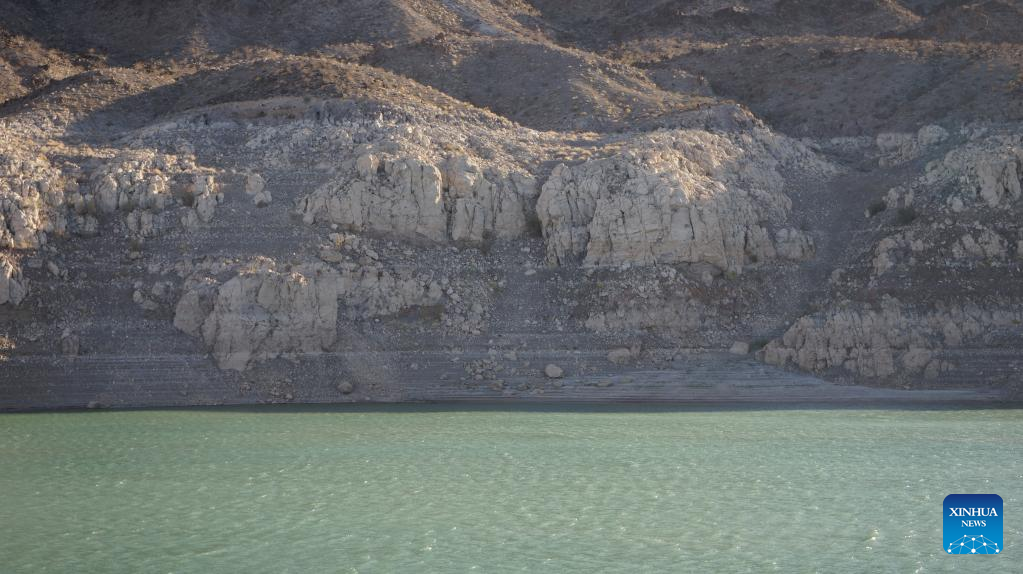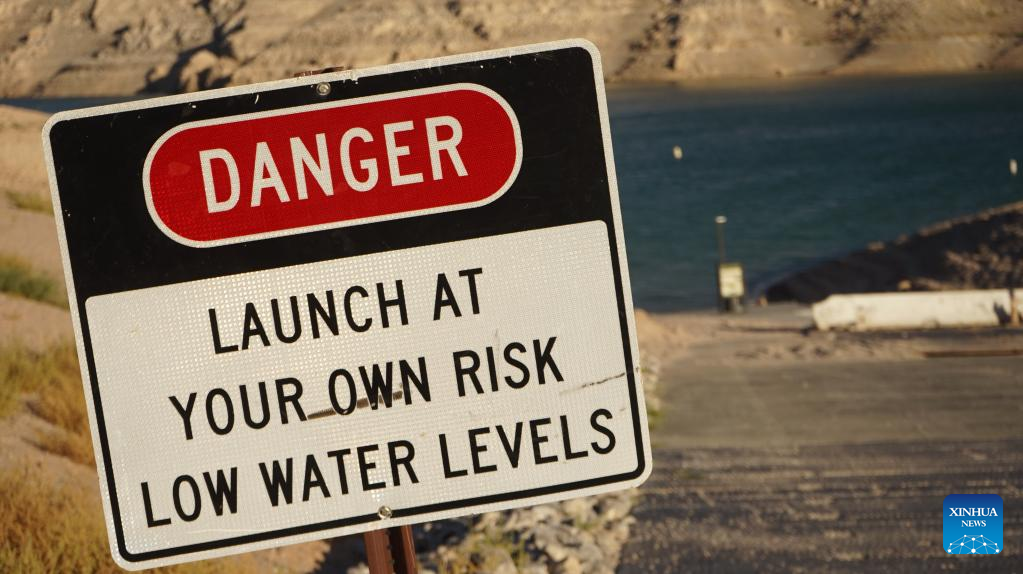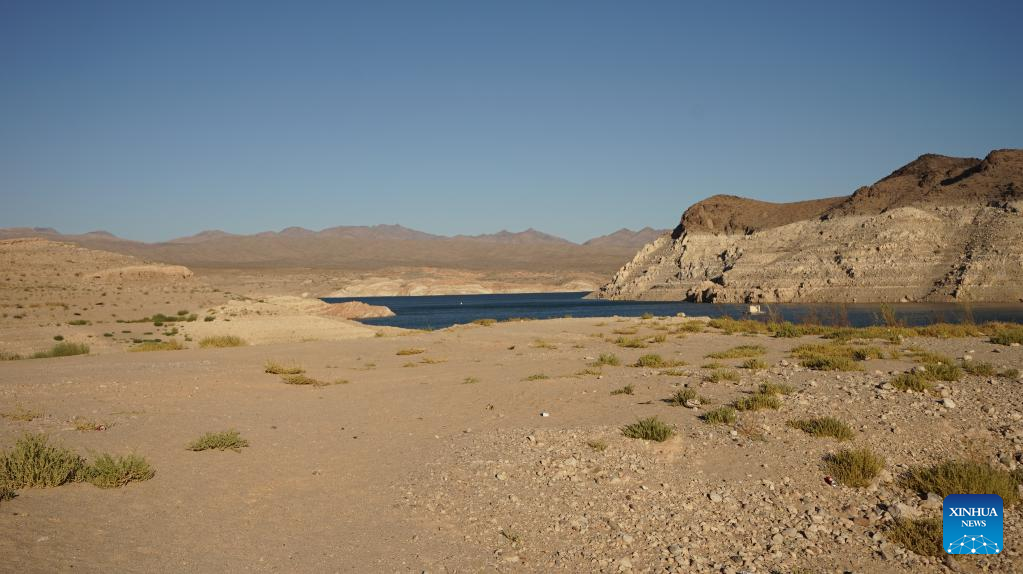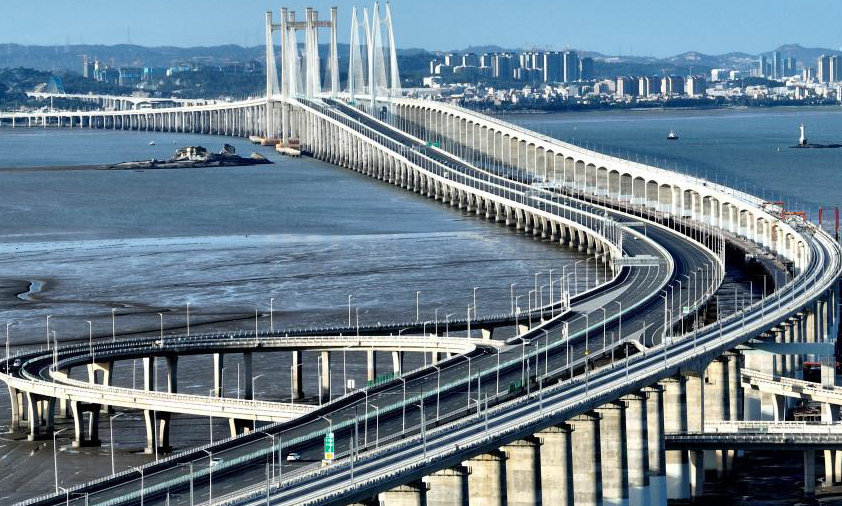U.S. biggest reservoir hits historic low level amid megadrought

Photo taken on July 5, 2022 shows a white band of dried rocks around Lake Mead near Echo Bay in Nevada, the United States. (Photo by Zeng Hui/Xinhua)
LOS ANGELES, July 8 (Xinhua) -- Surrounded by a white band of dried rocks, the vast drop in water levels is visible this week at Lake Mead, the biggest reservoir in the United States, which has been shrinking amid a two-decade-long megadrought.
The "bathtub ring" around the drought-stricken lake, on the Arizona-Nevada border and over 40 kilometers east of Las Vegas, is made of minerals deposited on the rock walls when the lake's water level was higher.
Some boat launching ramps along the lake were closed due to the low water levels. Lots of things underneath Lake Mead have resurfaced in recent weeks, including formerly sunken boats, as the lake's water level is continuing to decline.
Lake Mead's water levels have dropped to historic lows since it was filled in the 1930s. As of Thursday night, the water in the lake, formed by the Hoover Dam on the Colorado River, was around 1,042.3 feet above sea level - a decline of more than 43 feet from 1,085.95 feet by the end of January 2021, according to data from the U.S. Bureau of Reclamation.
The highest recorded level of the lake was in 1983 when it was 1,225 feet above sea level. The U.S. Bureau of Reclamation's 24-month outlook released last month said it was forecasting the most probable lake level would be 1,014.86 feet by September 2023.
Lake Mead currently provides municipal water for the cities of Las Vegas, Henderson, North Las Vegas, and Boulder City, as well as municipal and industrial water and irrigation water for downstream users, according to the U.S. National Park Service.
"Altogether, about 25,000,000 people rely on water from Lake Mead, and it is unlikely that the Southwest could have developed as it has without it," said the agency in an overview of the lake on its official website.
The lake is nearing "dead pool status," NBC, a major broadcasting television network in the country, noted in a report last month.
If the reservoir drops below 895 feet - a possibility still years away - the lake would reach dead pool status, with potentially catastrophic consequences for millions of people across the U.S. states of Arizona, California and Nevada, and parts of Mexico, said the report.
"The situation is critical," commented the Los Angeles Times, the biggest newspaper on U.S. West Coast, in a report earlier this month.
If the lake's surface drops another 150 feet, there will not be enough water flowing through Hoover Dam to supply large metropolitan centers downstream, including Las Vegas, Phoenix, Los Angeles and San Diego, explained the newspaper, adding that "When that happens, Lake Mead will be a 'dead pool'."
The megadrought is draining Lake Mead faster than anticipated, Las Vegas Review-Journal, the largest circulating daily newspaper in Nevada, pointed out in a report last month.
Water shortages and demand on the Colorado River Basin will require reductions in water use of 2 million to 4 million acre-feet in 2023 to preserve "critical levels", said the report, citing Bureau of Reclamation Commissioner Camille Calimlim Touton.
Last August, the federal government declared a shortage on the Colorado River for the first time, triggering substantial cutbacks in water deliveries to the U.S. states of Arizona and Nevada, as well as Mexico. Many Arizona farmers have left some fields dry and unplanted, and have turned to more groundwater pumping, the report added.
The megadrought that has gripped the southwestern United States for the past 22 years is the worst in at least 1,200 years, NBC News reported in February, citing a research published in the journal Nature Climate Change.
Jason Smerdon, one of the study's authors and a climate scientist at Columbia University's Lamont-Doherty Earth Observatory, was quoted as saying by the news outlet that global warming has made the megadrought more extreme because it creates a "thirstier" atmosphere that is better able to pull moisture out of forests, vegetation and soil.
"As much as 80 percent of the 17 western states that comprise the U.S. Bureau of Reclamation's area of operations have experienced severe or worse drought conditions at times during the past two decades," Jonathan Deason, co-director of the Environmental and Energy Management Institute at George Washington University, told Newsweek in a report last month.
While the Colorado River has been affected by previous droughts, a warming climate is predicted to alter the water cycle in new ways. Long range climate predictions are for warmer winter temperatures in the Southwest, less snowpack in the Rocky Mountains, and less melted snow able to find its way into the Colorado River, the U.S. National Park Service noted on its website.
Droughts in U.S. West have also led water levels in many other major lakes to drop dramatically. Shasta Lake, the largest reservoir in California, is reportedly at less than half of where it usually should be in early May. Water level of the Great Salt Lake in Utah hit historic low earlier this month for the second time in less than a year.

Photo taken on July 5, 2022 shows a white band of dried rocks around Lake Mead near Echo Bay in Nevada, the United States. (Photo by Zeng Hui/Xinhua)

Photo taken on July 5, 2022 shows a sign warning people about the danger to launch boats due to low water levels near Echo Bay, Lake Mead, Nevada, the United States. (Photo by Zeng Hui/Xinhua)

Photo taken on July 5, 2022 shows a view of the shrinking Lake Mead near Echo Bay in Nevada, the United States. (Photo by Zeng Hui/Xinhua)

Photo taken on July 5, 2022 shows a white band of dried rocks around Lake Mead near Echo Bay in Nevada, the United States. (Photo by Zeng Hui/Xinhua)

Photo taken on July 5, 2022 shows a white band of dried rocks around Lake Mead near Echo Bay in Nevada, the United States. (Photo by Zeng Hui/Xinhua)

Photo taken on July 5, 2022 shows a view of the shrinking Lake Mead near Echo Bay in Nevada, the United States. (Photo by Zeng Hui/Xinhua)
Photos
Related Stories
- US main driver for turning outer space into weapon, battlefield: MFA
- Washington spends 250 mln USD on biowarfare activities in Ukraine: Russian Defense Ministry
- "Guardrails" for China-U.S. relations are three joint communiques: FM spokesperson
- U.S. largest lithium mining project faces strong resistance
- Nearly half of Americans "struggling" with high inflation, soaring gas prices: poll
Copyright © 2022 People's Daily Online. All Rights Reserved.









